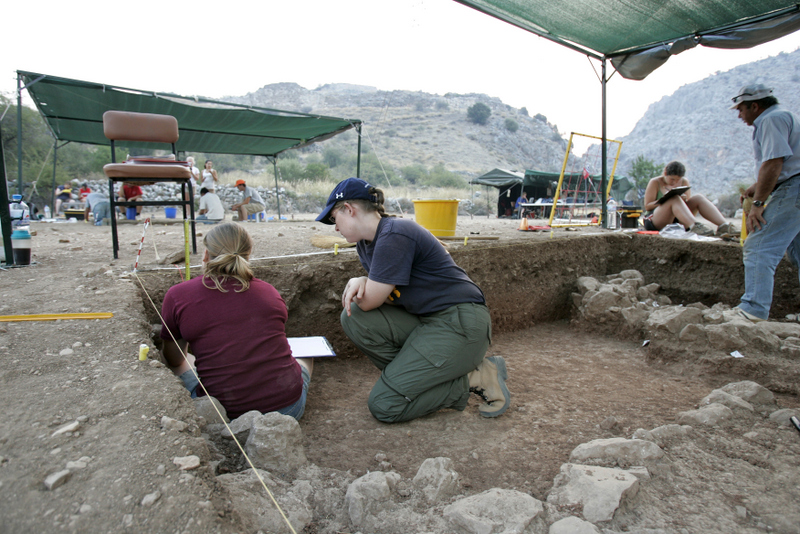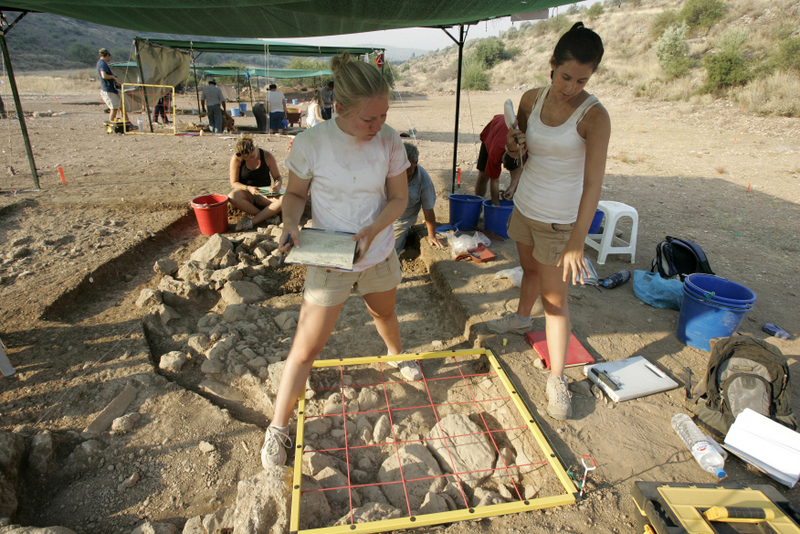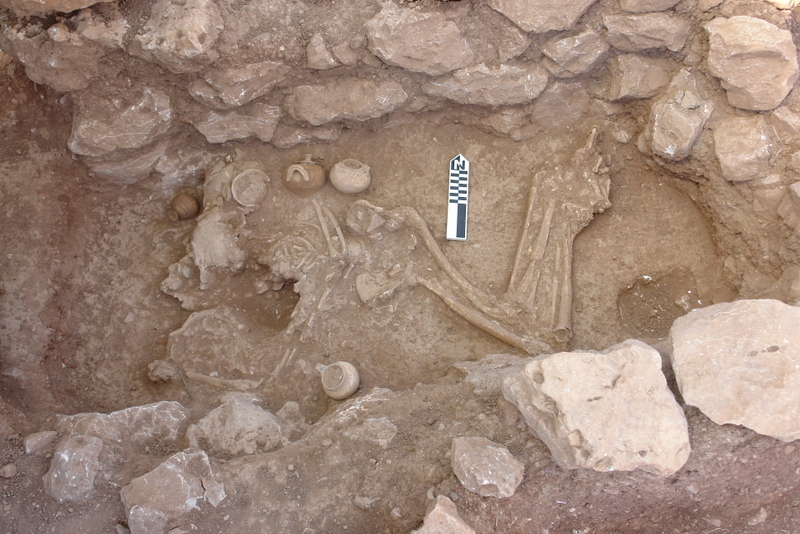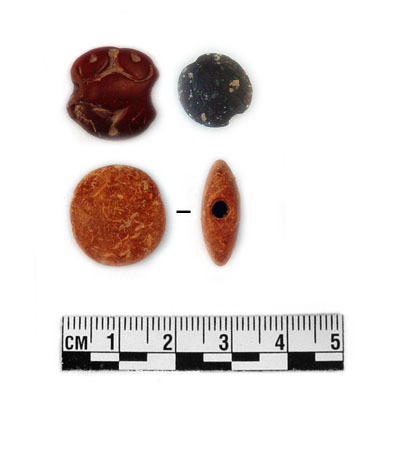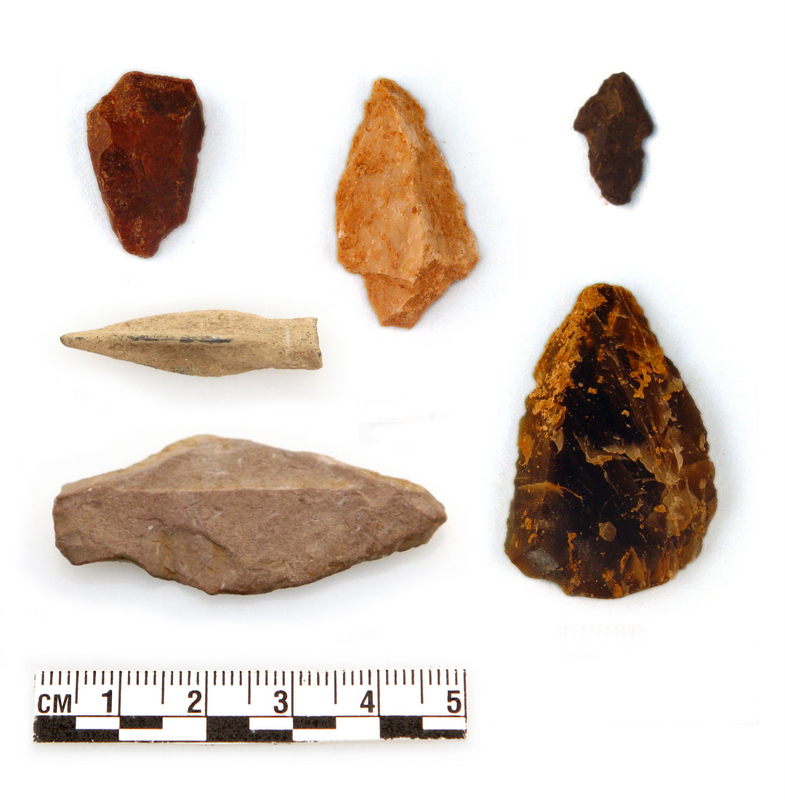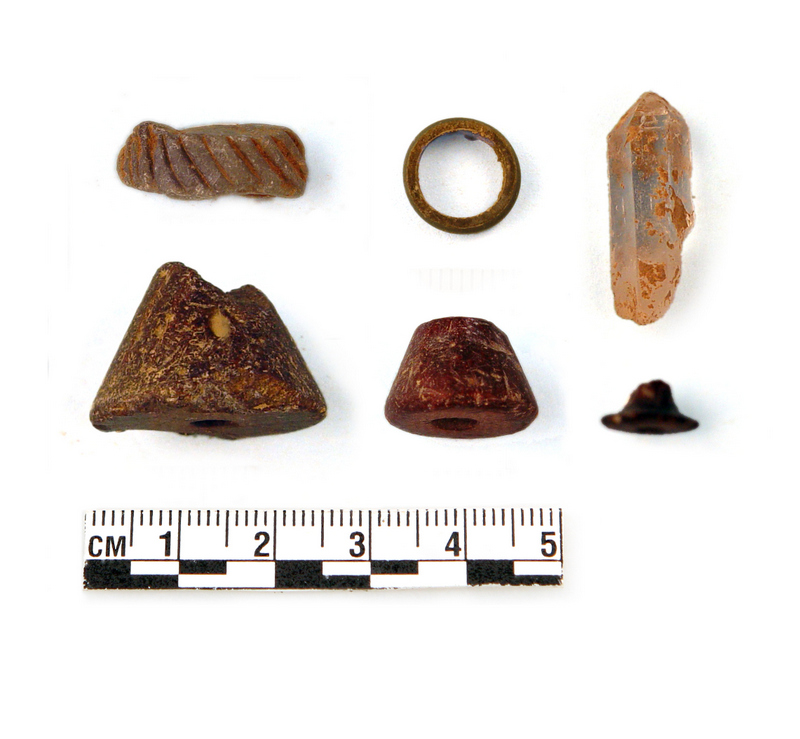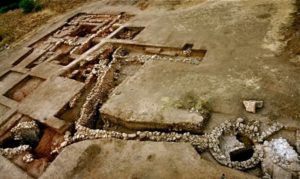
Homer, the great singer of tales, describes Mycenae as well built (euktimene), with wide streets (euryagyia), and rich in gold (polychrysos) in his famous epic poems Iliad and Odyssey. Such epithets were used repeatedly, interchangeably and rather conventionally for various cities in the formulaic language of Greek oral epic poetry – but not so for Mycenae. These three Homeric words epitomize vividly and effectively the complex archaeological picture of Mycenae that has emerged in the last two centuries. Systematic excavations and surveys of the site have revealed an imposing citadel fortified with massive cyclopean walls – a marvel of engineering – which comprised a magnificent palace, shrines and temples, workshops and storerooms, houses, and royal graves; outside the citadel walls was evidence of a large and densely populated town, extensive cemeteries with richly furnished royal shaft graves and monumental tholos tombs, an impressive water supply system of clay pipes, channels, underground cisterns, and dams; and finally, an extensive road network was traced connecting the citadel with its surrounding region and with select ports that gave access to trade routes all over the Mediterranean. Mycenae, a World Heritage site, was the leader of a closely-knit network of palatial states that shared a homogeneous culture – the fabled Mycenaean civilization.
The citadel of Mycenae, comprising an area of 30,000 m2, was built on a low rocky hill rising 278 m above sea level and approximately 40-45 m above the surrounding plain. The hill of Mycenae is nestled between two mountains, Profitis Elias to the north and Zara to the south, from which it is separated by two ravines formed by winter torrents, Kokoretsa and Chavos, respectively; it is, therefore, a natural stronghold, protected by deep gorges and steep rocky sides all around, except its western slope which is the only accessible side. The natural defensibility of the site was further enhanced by a formidable 900 m-long circuit wall built of huge boulders in the megalithic ‘cyclopean’ technique to imposing dimensions (12-15 m high and 5-8 m thick); furthermore, the citadel was supplied with fresh water by the Perseia spring which lies 360 m to the east and approximately 13 m higher than its summit. The hill of Mycenae and the adjacent mountains belong to the western part of the Arachnaion mountain range that divides the Argolid from Corinthia, and rise at the mouth of the only passage connecting the two regions and in the crossroads of the eastward routes to the Saronic Gulf. The hill of Mycenae, therefore, combines a strong geopolitical location, which controls access points to and from the Argolid, and a commanding view of the Argive plain to the south below.
________________________________________
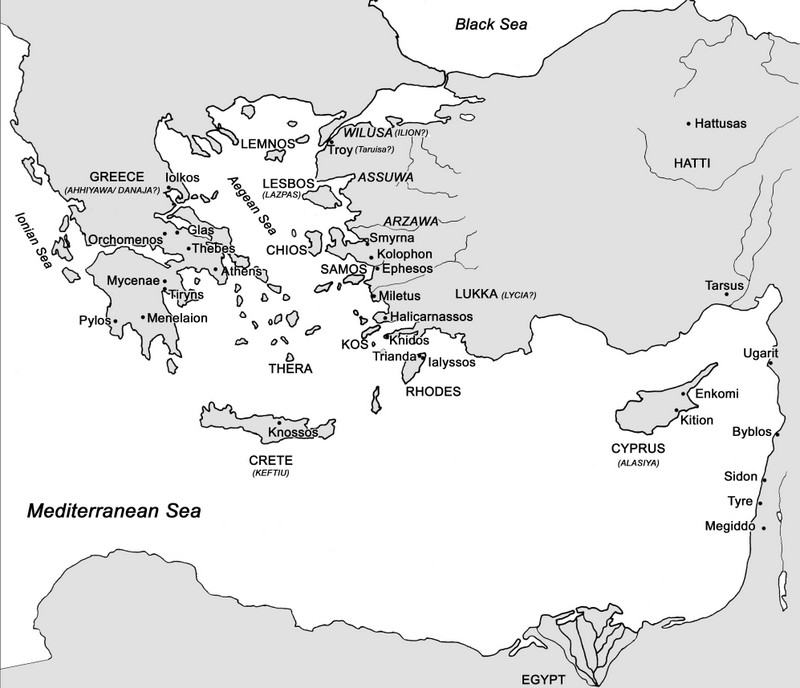 Map of the Late Bronze Age Aegean and Eastern Mediterranean, showing relative location of Mycenae.
Map of the Late Bronze Age Aegean and Eastern Mediterranean, showing relative location of Mycenae.
_______________________________________
A Brief History of Mycenae and the Mycenaean World
The first Greeks descended through the Balkans into mainland Greece in ca. 2300/2200 BC (beginning of the Early Helladic III). They settled down mainly in the fertile inland, formed villages and eventually small towns, organized egalitarian societies and developed a distinct regional culture (Middle Helladic) based on agricultural economy and limited trade contacts with the Cyclades and eventually Crete. Rising to power was a long process through trade, diplomatic contacts, and constant warfare abroad and at home during the formative Early Mycenaean period (Late Helladic I-IIA/B, ca. 1650-1420/1410 BC). The Mycenaeans proved to be meticulous students: through increasing contacts with Minoan Crete, their trade horizons gradually expanded from the Balkans and Northern Europe to Egypt, the Levant, Cyprus, and Asia Minor. This gradual expansion is documented in the multicultural amalgam of stylistic, iconographic, technical elements and materials of the exquisite finds in the royal Shaft Graves at Mycenae (Minoan, Egyptian, European/Balkan, Hittite, and Helladic influences), the extensive corpus of foreign imports in Greece (orientalia and aegyptiaca), and the increasing Mycenaean exports abroad. Contemporary iconographical evidence (e.g. flotilla fresco from Akrotiri at Thera, silver Siege Rhyton from Grave Circle A at Mycenae) illustrate some of the early military achievements of the rising new power abroad: raiding jointly with the Minoan fleet foreign exotic lands (Egypt?), sieging and sacking foreign towns. The Mycenaeans were recorded as “Ahhiya” or “Ahhiyawa” (~Homeric Achai(w)oi/Achaeans) in Hittite diplomatic documents already by 1420/1400 BC (since the reign of Tudhaliya II) and as “Danaja”or“Tanaja” (~ Homeric Danaoi) in Egyptian tribute lists like those of Thutmose III (ca. 1450 BC) and Amenhotep III (Karnak, ca. 1380 BC), or on a statue-base from Kom-el-Hetan (ca. 1380 BC), where “Mukanu” or mki[n] (~Mycenae) was listed first among mainland sites. In the following decades, the “Danaja” references in Egyptian sources gradually replaced the earlier “Keftiu” accounts and depictions of Minoan embassies of the 15th century BC, echoing contemporary archaeological evidence for drastic Mycenaean expansion and simultaneous reduction of Minoan presence abroad. This reversal of the political and military situation in the Aegean in the 14th century BC was triggered by the gradual infiltration and, arguably, military presence of the Mycenaeans on Crete in 1420/1410-1370 BC (Late Helladic IIIA1), in the wake of a devastating earthquake which had leveled the Minoan palaces and left the Minoan world in disarray. The Mycenaean occupation of Crete marked for the Minoans the beginning of the end and for the Mycenaeans the end of the beginning.
The Mycenaean world and particularly Mycenae flourished in the following two centuries (ca. 1420/1410-1200/1175 BC), a period known as Palatial Mycenaean or Late Helladic IIIA/B. The Minoan palaces served as modus operandi for the sociopolitical and economic organization of the rising Mycenaean states. This period is marked by regional centralization of power, state formation, and advanced socio-economic organization, geared towards efficient surplus local production and overseas trade, both coordinated and regulated by the palace administration and sustained by palatial bureaucracy (Linear B). At home, the Mycenaean palaces were fortified into citadels, large-scale public works were carried out, and production was systematized; at Mycenae, the cyclopean walls were constructed (1350 BC) and later expanded with the addition of the Lion Gate and postern gate (1250 BC), water supply was secured by means of an underground cistern and dams (1200 BC), a new palatial complex was built to replace an earlier palace (1300/1250 BC), the outer town expanded, and roads and bridges were built to serve the region of Mycenae. Abroad, the Mycenaeans assumed control over the Minoan colonies and trade outposts in the Aegean and Eastern Mediterranean, and further expanded to the east and west, thus firmly establishing their own trade network and successfully succeeding the Minoans in the overseas trade (Mycenaean thalassocracy). A vital sector of the centralized palatial economy and sociopolitical structure, overseas trade required not only a tight network of island and coastal outposts, but also highly effective diplomacy. Diplomatic contacts involved exchange of royal letters and gifts, ambassadors, official royal visits, treaties and bilateral agreements. Certain Mycenaean palaces like Mycenae, Thebes, and Pylos maintained a protagonistic role in overseas trade of luxury/prestige goods and diplomatic contacts at the highest level. The organized trade of luxury/prestige goods which required a well-coordinated control mechanism for acquiring raw materials and producing artifacts or other products to be marketed in exchange, afforded luxury to the elite, while the king’s special access to external prestige goods reinforced royal image and authority. The exquisite artifacts found in tombs in the area of Mycenae, Pylos, and Thebes, as well as the great variety of precious materials recorded in palatial inventory lists and yielded in the archaeological contexts of palatial workshops further document privileged connections and constant contact with Egypt, Anatolia, and the Near East, closely following the successful Minoan archetype.
In the course of the 12th century BC rapid, dramatic, and combined changes in several of the socio-economic, political, and environmental variables affected a fragile balance and triggered a chain reaction whose accumulating effect was progressively magnified and multiplied, resulting inevitably in a catastrophic systems collapse which caused the decline and fall of the Mycenaean world. The latter half of the 13th century BC was marked by intense and frequent seismic activity in certain regions of mainland Greece (two major destruction horizons were recorded at Mycenae in ca. 1240 BC and 1200/1180 BC). These ‘earthquake storms’ caused severe structural damage, local fires, disorganization and disarray, immediate allocation of manpower for costly and energy-consuming repairs, and hence disruption of economic life and trade. A typical example of a low-diversified surplus-geared economy without sufficient alternative resources to fall back to, the Mycenaean economy could hardly withstand and recover from temporary setbacks or survive the combined impact of various factors, such as natural catastrophes (earthquakes, extensive fires, severe climatic conditions, droughts, crop failure), ecological overexploitation, and palatial military/financial overextension. Natural disasters may have acted as catalysts for a catastrophic system failure, inflicting the final blow to the system: they eliminated short-term food supplies, destroyed high-yield specialized agricultural production and livestock, and consequently upset dependent satellite industries (flax, textile, wine and oil industries), disrupted trade, damaged the infrastructure, and demoralized the population. Inevitably, civil unrest, internal wars and raids by starving populations on less affected regions followed, causing decentralization and political fragmentation, dissolution of the socioeconomic nexus, severe depopulation of vital areas, and emigration to the coasts, islands, and overseas. The movement of peoples (called “Sea People” in the Egyptian sources) and the subsequent widespread destructions in Asia Minor and the Levant in the beginning of the 12th century BC led to the collapse of the Hittite Empire, but also eradicated the Mycenaean trade outposts and colonies in the East. The loss of their off-shore trade posts disrupted foreign trade and paralyzed the overseas sector of the centralized palatial economy, which, given the peripheral geopolitical location of Mycenaean Greece, depended on the contact with the main zone of exchange through intermediaries. That must have been another terrible blow to the already distressed and staggering palatial economy, forcing it to fall back on domestic production and isolation. In the course of the 12th century BC many small settlements in several regions (i.e. Argolid, Achaia, Attica, Euboia, Thessaly, islands, Cyprus, Asia Minor) sustained continuity and achieved substantial revival with their limited production and trade capacity, despite the general decline and fragmentation; on the contrary, the citadels of Mycenae, Tiryns, and Thebes, though partially repaired and reoccupied, and despite attempts for economic revival, never fully recovered and were gradually abandoned. The deterioration of the same system that had strengthened central palatial authority through the coordination and regulation of political and socioeconomic life resulted inevitably in the dissolution of the palaces’ power, decentralization and fragmentation of Mycenaean Greece. It appears, therefore, that it was the Mycenaean elite and its diagnostic, key elements (palatial administration and writing, foreign contacts and luxury goods, monumental art and megalithic architecture) that suffered the most from the system meltdown, whereas at a lower level the impact was less direct, and the core of Mycenaean society changed more gradually (in terms of basic material culture and cultural practices) and evolved organically into the Early Iron Age Greece.
History of Excavations
Mycenae was first explored in 1841 by K. Pittakis on behalf of the Athens Archaeological Society; Pittakis cleared the area of the Lion Gate, the Treasury of Atreus and the Klytemnestra tholos tomb. Mycenae, however, was brought into the spotlight of worldwide acclaim by H. Schliemann in 1874/1876 who, following the description of the ancient traveler Pausanias, discovered five royal shaft graves in Grave Circle A (a sixth shaft grave was later excavated by P. Stamatakis), all furnished with unprecedented treasures of jewelry, weapons, vases, and other exotic artifacts and materials. This discovery, which followed Schliemann’s own excavations at Troy and his discovery there of the so-called ‘Priam’s Treasure,’ secured for Schliemann the title of the ‘father’ of Mycenaean archaeology and established the existence of the Mycenaean civilization (quite befittingly named after the most famous and powerful citadel, the seat of legendary king Agamemnon, and the first to be excavated on mainland Greece). In 1884 Captain B. Steffen mapped the area of Mycenae (Karten von Mykenai). In 1886-1897 Chr. Tsountas excavated most of the citadel, five tholos tombs and over one hundred chamber tombs. In 1920 the British School under A.J.B. Wace took over the investigation of the site; Wace excavated several sectors of the citadel, several buildings outside the walls, four tholos tombs and many chamber tombs, and published his results in monumental publications (1920-1957). Lord W. Taylour continued his work in the cult center of the citadel (1959-1969). Meanwhile, the Athens Archaeological Society resumed the investigation of the site with the accidental discovery, excavation, and monumental publication of the royal Grave Circle B outside the walls by G. Mylonas and I. Papadimitriou (1951-1954). In 1958 G. Mylonas resumed the investigation of the citadel on behalf of the Athens Archaeological Society; he excavated several sectors of the citadel as well as houses and chamber tombs outside the walls (1958-1988). He was succeeded by S. Iakovidis (1988-2013) who excavated various sectors and buildings inside and outside the citadel and published the results of earlier excavations. Iakovidis conducted jointly with E. French and the British School an extensive archaeological survey of the wider area of Mycenae (Archaeological Atlas of Mycenae). Chr. Maggidis worked with Iakovidis on Building K inside the citadel (2002-2008) and has been publishing earlier excavations (Palatial Workshops); meanwhile, Maggidis conducted an extensive geophysical survey of the surrounding area that led to the discovery of the Lower Town (2003-2013), and has been excavating sectors of the Lower Town since 2007.
Was there ever a Lower Town at Mycenae?
Since the commencement of the systematic investigation of Mycenae by Heinrich Schliemann in 1874, the excavation of the site has focused mainly on the citadel itself, comprising approximately 70% of the total fortified area. Outside the walls, work has been limited to royal cemeteries of shaft graves and tholos tombs, and a fair part of the extant chamber tomb cemeteries stretching farther on the hill slopes around Mycenae. Unfortunately, only a very small segment of the settlement once surrounding the citadel (12-13 completely or partially excavated buildings) has been brought to light, mainly west or north of the citadel. Although some of these structures are clearly domestic units (Panagia group), others (Oil-Merchant complex) appear to have been a combination of residential areas, storerooms, and workshops, which are plausibly interpreted as palatial buildings and annexes connected with palatial economy, bureaucracy and administration. An extensive archaeological survey which was jointly conducted by the Athens Archaeological Society and the British School at Athens in the 1990s, located, identified and mapped all visible remains throughout the wider area of Mycenae (32 hectares), including more than 750 sites, structures, buildings, guard towers, beacons, wall remains, tombs, roads, and bridges. However, the discovery of scattered, isolated building groups of both palatial and residential use, oddly intermingled with tholos tombs and served by separate drain systems, have led scholars to suggest that the citadel of Mycenae was surrounded by several loosely connected small settlements, each with its own cemetery. According to this theory, such satellite settlements must have gradually expanded from original nuclei in an additive, open plan and eventually framed the highways and roads leading to Mycenae. The alleged absence of large-scale urbanization has been repeatedly hypothesized for Mycenae and other Mycenaean centers. Such views were apparently fueled by the lack of sufficiently extensive excavations of settlements on mainland Greece and especially of the sites surrounding the main palaces and citadels of Mycenae, Tiryns, Pylos, Thebes, Orchomenos, and Athens. This picture, though, is at variance with the textual evidence of the Linear B tablets for Mycenaean political geography, administration, and socioeconomic organization of the Mycenaean states. Furthermore, in recent years intensive and extensive regional surveys on the mainland have produced important spatial analysis of settlement patterns; meanwhile, renewed excavation at palatial sites and their surrounding areas (Mycenae, Tiryns, Thebes, Pylos) and systematic extensive excavation of several Mycenaean settlements combined with the textual evidence and regional survey data, reveal emerging settlement patterns consistent with varying degrees of localized urbanization.
Detecting the Lower Town
The terraces at the south foothill of the citadel and opposite the Atreus Treasury are located in the most prominent area en route to Mycenae; paradoxically, however, these terraces yielded no visible remains during the archaeological surface survey of the 1990s, apparently due to their deep river alluvium deposits. It was aerial reconnaissance that triggered the detection and led to the discovery of the Lower Town. The software-enhanced analysis of high-resolution aerial photographs of the area around Mycenae, taken in the spring of 1988 and kindly supplied by the Greek Military Geographical Service (G.Y.S.), revealed upon careful inspection distinct ‘ghost traces’ of walls as crop/soil marks on several terraces south of the citadel. These aerial photographs of Mycenae were also used in conjunction with a silo-locating military program (ERDAS Imagine 8.4) that compares visible, recognizable features within the photograph to other features that match the set parameters in order to produce the resulting image of a site prediction model. The areas in red were the most interesting because they picked up likely features in the very same locations targeted by the archaeological survey and highlighted on the aerial photograph as producing ghost traces. These areas (SEB I, SWB I-VII) were finally selected as being most likely to produce promising remote-sensing results and physical remains by excavation.
Subsequently, a systematic geophysical survey was launched at Mycenae by Prof. Chr. Maggidis under the auspices of the Athens Archaeological Society (2003-2013) with the generous funding and technical support of Dickinson College, the Institute for Aegean Prehistory (INSTAP), the Mycenaean Foundation, and the Geophysical Laboratory of the Aristotle University of Thessaloniki. Several ground-based remote-sensing methods were combined to map all visible and buried structures in the area around the citadel, to locate buildings, sectors and roads of the settlement of Mycenae outside the walls, and ultimately to create a 3-D digital model of the buried remains of the Lower Town of Mycenae. The targeted area is located immediately south of the citadel on the terraced fields flanking the dry riverbed ravine of Chavos: South East Bank (SEB), South West Bank (SWB). The survey area was selected after careful examination of the local geomorphology (artificially terraced land, thick undisturbed fill, sealed and protected by successive river alluvium deposits) and consideration of several topographical and archaeological variables. More than 50 grids were surveyed with Ground Penetrating Radar, Fluxgate Gradiometer, and Electrometer on six separate terraces on both banks. Plotting and mapping of the survey grids was carried out by means of differential GPS and Total Station. The survey data, the geomorphology of the study area, the archaeological remains and topographical parameters have been integrated in a GIS model.
_____________________________________
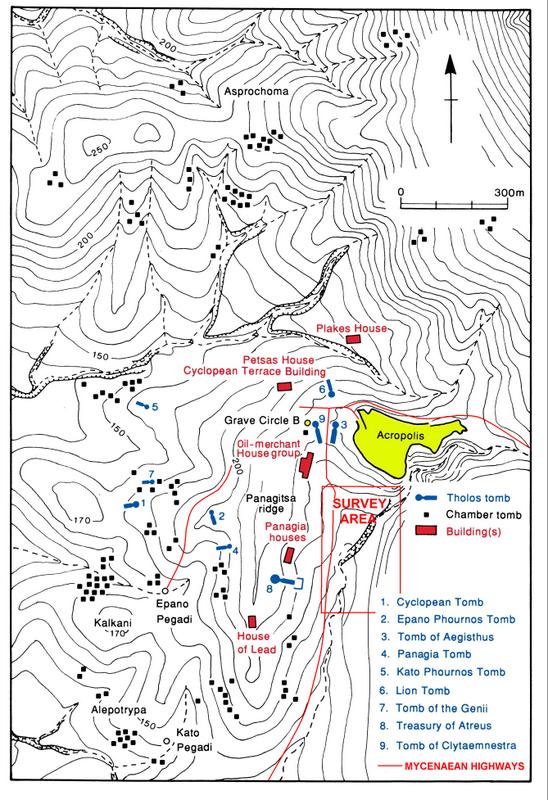 Map of Mycenae, showing location and extent of survey area in relation to the acropolis where the citadel is located.
Map of Mycenae, showing location and extent of survey area in relation to the acropolis where the citadel is located.
____________________________________
In general, the remote sensing revealed walls, structures, buildings, features, gates and roads at two different depth ranges (0.40–1 m and 1.20–2 m) which consistently pervade most of the surveyed contexts; these depth ranges define possibly two superimposed occupation horizons, including an overlying Geometric/Archaic and an underlying Mycenaean level, accordingly, which are further set apart by the distinct types, size, and orientation of their structures. The South West Bank grids have produced the most interesting results so far. One of the most important finds of the geophysical survey was identified in the SWB Vb grid: at a depth of –0.68 m emerges a road surface (3 m wide) running N–S (roughly parallel to the modern road and roughly aligned with the Oil-Merchant complex), which may well be the northbound highway leading up to the citadel through the settlement. Two L-shaped, solid features to the north and on either side of the road may be gates or towers, considering their diagnostic shape and large size (at least 3.5 m wide, preserved to a total height of approximately 1 m). This feature is strikingly similar to another structure located at the extreme edge of the Panagitsa hill and labeled by Steffen in 1884 as a gate. What appears, therefore, in the radar image on grid SWB Vb must be the main gate into the Lower Town of Mycenae (Central Gate). Another gate and part of the impressive 5 m-thick outer fortification wall were further traced by the gradiometer on terrace SWB IIb by the western bank of Chavos (East Gate). This gate is connected perhaps with the retaining wall along the western bank and the remains (rock-cuttings) of a Mycenaean bridge at the mouth of the gorge, which it may have served. Several other structures were traced, identified and mapped, including two large buildings (SWB III) and an immense, multi-room compound (SEB I). Furthermore, all nine tholos tombs of Mycenae were surveyed, revealing interesting details of construction and topography. The discovery of these important landmarks sheds new light on the elusive topography and complex road network of the settlement around the citadel of Mycenae, and forms the basis for land expropriation and systematic excavation of the settlement of Mycenae.
__________________________________
 GPR/Gradiometer map of the Lower Town (excavated area and gates)
GPR/Gradiometer map of the Lower Town (excavated area and gates)
_____________________________________
The number, size, type, and spatial distribution of the extant features, structures, and buildings traced thus far by remote-sensing seem to support the possibility of a sizable urban center surrounding the citadel on the west, south, and north sides: this town may have extended over an area of ca. 30-50 hectares (with a normal population density of 200 people per hectare), consisting mainly of domestic units and commercial buildings, but also including larger palatial structures and annexes (workshops, offices, storerooms) located closer to the main access roads and highways. The discovery of two gates, associated perhaps with an outer circuit wall, further reinforces the possibility of an organized town plan; to this conclusion point also definite town boundary markers that appear to have been in place already by the late 14th century BC. The peripheral spatial distribution of the cemeteries which form a circle farther around the citadel and the settlement demarcates the borders of the Lower Town, thus revealing a site pattern of three successive and concentric occupation zones (palatial, residential, and cemetery). The discovered buildings outside the walls belong to three different types, the oblong corridor plan, the square version with rooms arranged around a central court, and the megaron type; all three types have been also identified in the radar images on the south, terraced slope. Furthermore, it appears that although the palatial annexes outside the walls were destroyed by earthquake and fire in ca. 1240 BC and were subsequently abandoned, several residential buildings were repaired and continued to be in use well into the 13th/12th c. BC along with a number of chamber tombs, a pattern which is consistent with the composition of a town.
The geoarchaeological study of the Chavos area and the examination of the geomorphology, sedimentology, and stratigraphy of the excavated sectors identified two superimposed natural fills. These fills define two distinct stratigraphical and chronological horizons, namely a thick and coarse reddish-brown sterile colluvial fill with cobbles and boulders emerging at the depth of -2.5 m (water flow) and an overlying red fill with fine sedimentation (debris flow). The deeper colluvial fill was probably formed by recurring overflows and extensive flooding of the Chavos river, as indicated by the depth of sedimentation and the horizontal grading of the deposited material. The soil micromorphology of this fill reveals traces of ground surface morphogenesis, which means that it must have been exposed to the elements and subject to severe weathering for a prolonged period of time before it was gradually covered by various structures in the Mycenaean period. In the 13th century BC, a strong retaining wall was built alongside the western bank of Chavos following its N-S orientation in order to delineate and narrow down the riverbed, contain the river flow, and protect the adjacent flat land to the west from recurring overflows and flood. This facilitated the spatial re-organization of landscape to accommodate the expansion of the south sector of the Lower Town. The Chavos river was successfully contained, as documented by the deposition of finer sedimentation in later fills and the absence of rocks and boulders therein. The strong water flow was controlled by a water dam which created an artificial pond further south securing water supply for irrigation. All these hydrologic modifications and their relative environmental impact aimed at a drastic transformation and spatial re-organization of the surrounding landscape, thus serving a systematic modification of farmland to domestic, industrial, and burial space. Systematic geoelectrical prospection combined with targeted deep-core drilling and soil micro-morphology further defined the paleogeomorphology of the area and detected ancient hydrologic, landscape, and environmental changes. The decline of Mycenae and gradual abandonment or destruction of the Mycenaean engineering projects (terraces, retaining walls, dams) in the early post-Mycenaean period resulted in the gradual accumulation of a natural red fill, a buildup of soil caused by slope erosion and river overflow over a long period of time (debris flow). This natural fill upon which (or cutting therein) the later Geometric and Archaic structures were founded, emerges at the same depth in the trenches of the excavated sector; therefore, the red fill defines a naturally formed stratigraphical and chronological horizon which seals, protects, and separates the underlying Mycenaean structures and contexts from the overlying superimposed Geometric and Archaic layers, thus connecting the excavated contexts and unifying the stratification of the whole site.
The final results of the geophysical and geoarchaeological survey are currently publication-ready in a collective volume (forthcoming in 2014).
Unearthing the Lower Town
The systematic excavation of the Lower Town at Mycenae (2007-) is conducted under the auspices of the Athens Archaeological Society with the generous funding and technical support of Dickinson College, the INSTAP, and the Mycenaean Foundation. The first phase of excavations focused on the South Sector of the settlement, and more specifically on the western part of terraces I/II of the South-West Bank. One acre of the surveyed land was purchased in 2006 with funds from Dickinson College and two more acres were bought in 2011. In the topographical grid of Mycenae, the purchased land falls within grid-squares D4 and E4 (500 × 500m). All the field campaigns so far have targeted the northern part of the purchased land (SWB II), where thirty 5×5m grid squares were excavated yielding substantial structures which had been traced by the geophysical survey with remarkable precision; these include houses, workshops, building complexes, intramural graves, retaining and defensive walls. In general, architectural features and structures of the settlement at Mycenae emerge at the depth of -0.10/0.15 m to the depth of -2.5 m. Their layout and spatial distribution reveal different orientation patterns of chronological significance: Mycenaean buildings in the deeper stratum follow a N-S orientation, parallel to the main northbound road to the citadel, whereas later structures appear to be oriented NW-SE. The Mycenaean structures include a solid and long retaining wall that was possibly connected with a gate (Wall A), and a late Mycenaean/Geometric wall (Wall B and Γ) which may have served as an auxiliary outwork connected with the outer fortification wall of the Lower Town or as a barricade of the Early Iron Age settlement, to judge from its relatively solid construction and size, the presence of an indentation, and the dense distribution of many arrow heads and sling stones in the vicinity of the wall. Mycenaean buildings include Building VII, Building VIII, which is delineated by two solid, well-built walls (Walls Δand E), and an apsidal structure (Building IV) consisting mainly of a solid curved wall which progressively narrows and funnels downwards (3.20 m × 4 m). The apsidal structure was founded directly upon the natural bedrock, which has been carefully hewn to form five successive steps giving access to the bottom of the apsidal structure at a depth of -3 m from ground level. The depth, downward tapering, carved steps, fill sedimentation and wet silt/sandy fills indicating presence of stagnant water in the interior of the apsidal structure corroborate the tentative identification of a cistern or well. The apsidal structure was originally constructed in the late Mycenaean period and continued to be in use as a cistern or well in the following centuries, as indicated by its successive repairs, modifications and extensions, until the Archaic period when it collapsed and finally went out of use, being subsequently filled-in with trash and debris.
__________________________________
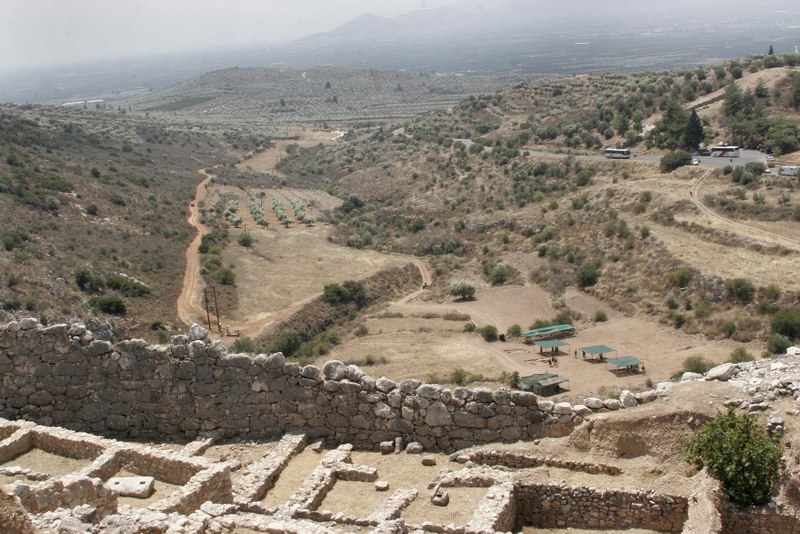 View of the Lower Town of Mycenae (from north)
View of the Lower Town of Mycenae (from north)
___________________________________
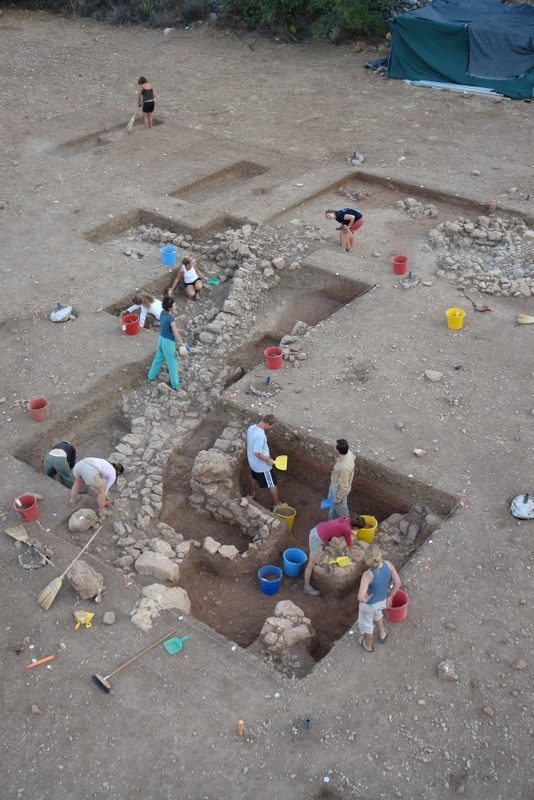 Overhead view of excavation team at work
Overhead view of excavation team at work
________________________________
_______________________________
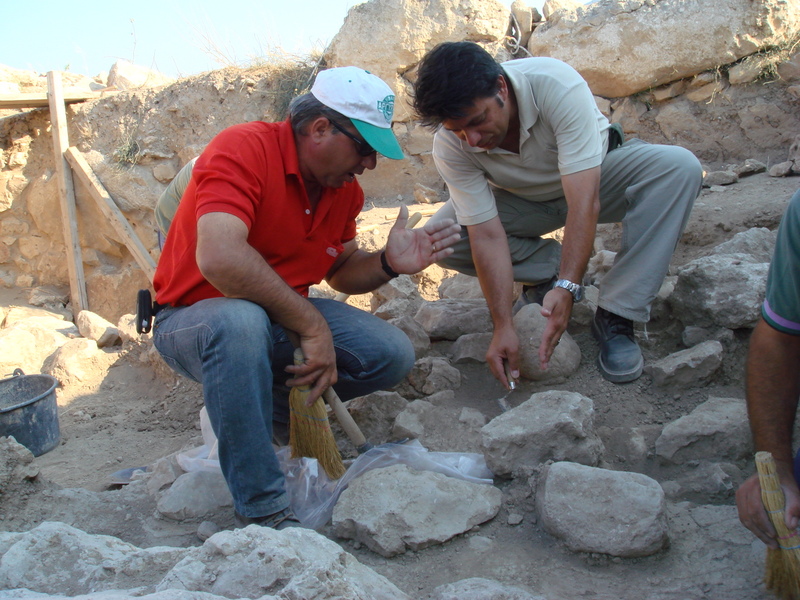 C. Maggidis (field director) and A. Tentzeris (foreman) at work
C. Maggidis (field director) and A. Tentzeris (foreman) at work
_________________________________
__________________________________
The Mycenaean remains were eventually filled-in, sealed, and protected from later intrusions by a thick, sterile, natural red fill which accumulated gradually from slope erosion and river overflow as a result of the abandonment or destruction of the Mycenaean infrastructure in the early post-Mycenaean period. Later on, Geometric (10th-8th c. BC) and Archaic structures (7th/6th c. BC) were founded upon this natural fill (or cutting therein). The most important Geometric structures include a pottery/ivory workshop (Building I) equipped with a cistern (possibly for storage of fine clay), a multi-room house with a courtyard (Building II), which yielded three intramural burials of infants under the floor of Room 4 (G-2, G-3), and two solid circular structures with an inner diameter of 2.5 m abutting the curtailed Wall Γ (Buildings V and VI). Building V was founded upon a Mycenaean building (Building VII), which was embedded in the circular structure to retain and carry its cobbled floor, and, after going out of use, was partially overlaid by an Archaic clay plaster floor. Building V was apparently a silo (granary), used for storing and processing agricultural products, as indicated by its circular ground plan, the discovery of stone tools and grinders, clay loom weights and spools in its interior, and its association with an adjacent and contemporary circular structure of similar use (Building VI). An earlier apsidal structure (Building III) was uncovered below the floor of Room 1 of Building II, consisting of a thin curved wall and an extensive stone layer, which probably formed the floor underlayment of the apsidal building. Building III was founded upon the post-Mycenaean red fill and was sealed by the overlying Middle Geometric Building II, which was founded directly upon its ruins. The apsidal Building III, therefore, should be dated to the Protogeometric (11th/10th c. BC) or Early Geometric period (900-850 BC). Finally, abutting high onto the eastern face of Wall B was found a rectangular, rubble-built cist grave (int. dim. 1.75-1.80 m × 0.75-0.95 m) of E-W orientation, cut into the post-Mycenaean fill. The cist grave G-1 (see Middle Geometric Grave G1 image below) was found practically undisturbed: food offerings and remains of funerary meals were found in situ on top of the grave, which contained a single adult burial interred in a contracted position, resting on its right side with the head oriented westwards and facing south. The articulated skeleton of a young woman was well-furnished with an iron pin (found in situ on the right shoulder-blade), an iron ring (found in situ around a phalanx of the right hand), and five clay vases, carefully lined behind the back of the body (two small footed jars, a small pithoid vase, and a pyxis with lid), or placed in front of the body and beside the right hand (one-handled cup). The cist grave is securely dated to the late 9th century B.C. on the basis of the Middle Geometric Argive pottery and jewelry found in its context. The particular geomagnetic trace of this grave on the geoprospection images is diagnostic of other Geometric graves in the vicinity, where the southern part of the Geometric cemetery of Mycenae must have extended.
______________________________________
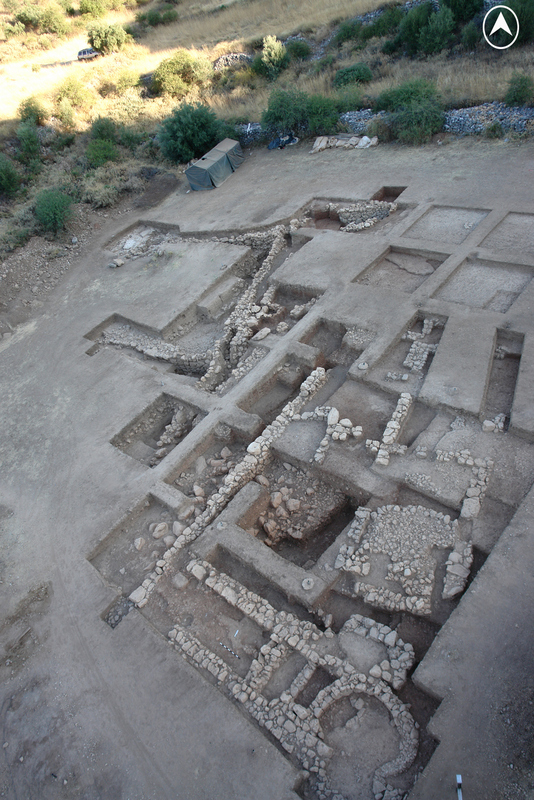 Aerial views of Lower Town of Mycenae: The excavated area, shown above and in following images
Aerial views of Lower Town of Mycenae: The excavated area, shown above and in following images
____________________________________
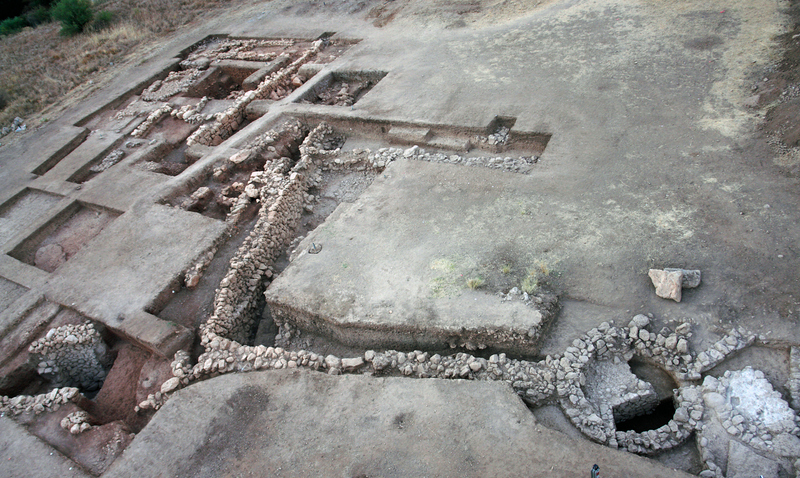 _______________________________________________
_______________________________________________
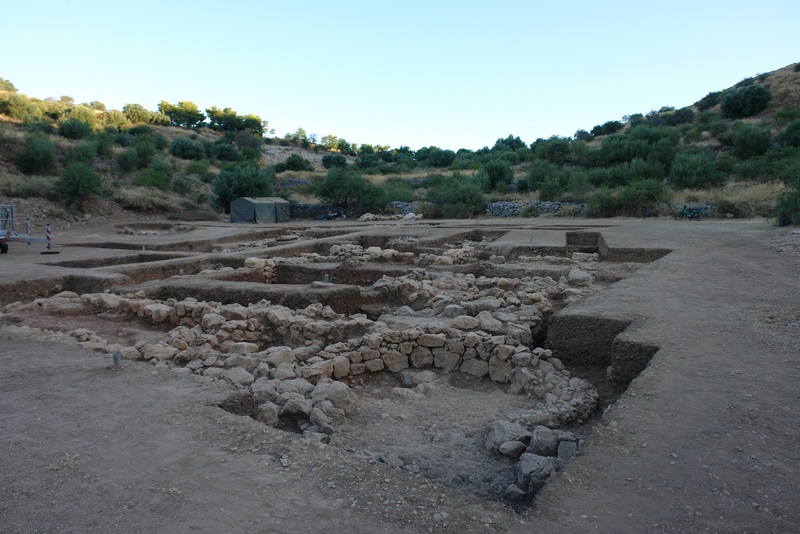 _________________________________________________
_________________________________________________
 __________________________________________________
__________________________________________________
___________________________________
A great number and wide variety of finds have been retrieved so far, including fragments of Mycenaean and Archaic figurines, flint and obsidian blades, flakes, and cores, stone tools, fragments of stone vases, stone cloth weights, seal-stones, beads and pendants, rings, glass shards, metallic objects, coins, lead sheets, iron nails and hooks, lead clamps for pottery mending, ivory objects, clay loom weights and spools, fresco and plaster fragments, color pigments, carbonized wood, animal bones, shell, roof tiles and abundant pottery (mainly Mycenaean, but also Geometric and Archaic). All excavated soil is sifted, and soil from uncontaminated closed contexts or undisturbed sealed layers is water-sieved. Soil samples are systematically collected for soil micromorphology (intact block samples consolidated with resin) and archaeobotanical analysis. The preliminary study of the archaeobotanical material has identified remains of grape pips, olive stones, figs, cereal grains, barley, and pulses. The analysis of animal bones has identified a wide variety of domesticated animals (sheep, goats, cattle and pigs, dogs, donkey) and wild species (wild boar, deer, red deer, hare).
______________________________________
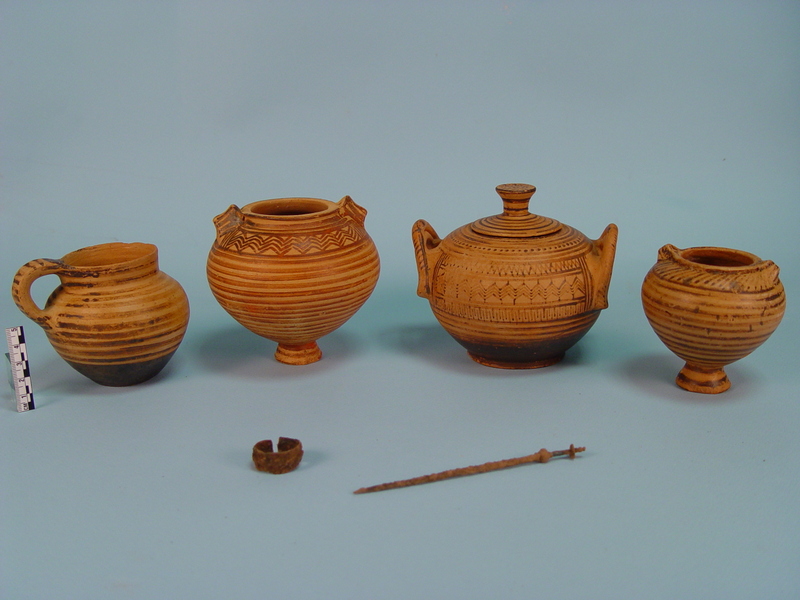 Grave goods from Middle Geometric Grave G-1
Grave goods from Middle Geometric Grave G-1
__________________________________
________________________________
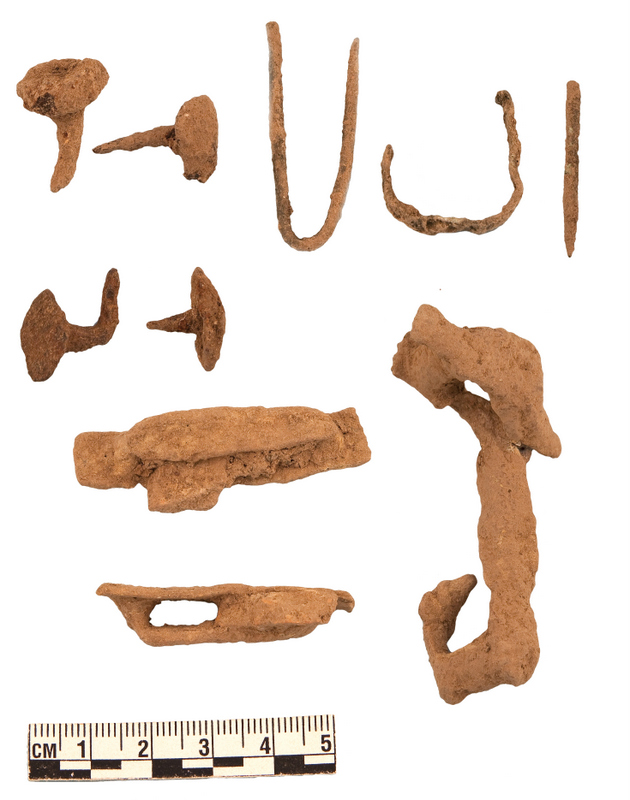 Lead clamps and iron nails and hooks
Lead clamps and iron nails and hooks
________________________________
_______________________________
________________________________
Assessing the Importance of the Lower Town
The geophysical survey and systematic excavation of the Lower Town at Mycenae (2003-2013) revealed an extensive Mycenaean settlement outside the citadel, which was protected by an outer fortification wall with gates, as well as overlying structures and buildings dating to the Early Iron Age (PG/G houses, workshops, silos, retaining walls, and graves) and the Archaic period, thus establishing for the first time a continuous, well-stratified occupation of Mycenae in all the successive periods from the 13th century BC to the 6th century BC. Such strong confirmation of continued presence following the decline of the palatial center of Mycenae and the subsequent political decentralization, economic collapse, and social dissolution, becomes very important, as it complements and reinforces the post-Mycenaean archaeological picture of transition in the Early Iron Age Argolid (Argos, Tiryns, Mycenae, Asine), and substantiates cultural continuity in the region.
The exploration of the lay-out, borders, size, and landscape of the town has radically changed the topography of Mycenae, and offered a better understanding of Mycenaean town planning and urbanization, and of the interaction between town and palace, production and storage, local workshops and trade patterns, ancient economy and environment. The geopolitical location of Mycenae, the commanding position of the fortified citadel, the interaction dynamics between settlement and palace, the spatial organization of the surrounding landscape and related hydrologic modifications, all pose intriguing geological, archaeological and paleoenvironmental questions. The geophysical survey at Mycenae detected patterns of ancient reorganization and transformation of the landscape, including terracing against soil erosion, successive modifications of farmland to domestic, industrial and burial space, deforestation, intensification and extensification of agricultural production, as suggested by archaeobotanical evidence and ensuing alterations of the water sources towards systematic irrigation. Towards an integrated synthesis, it is essential to understand the dynamics of the monuments with the formation/deformation processes of their related landscape ecosystem and their relative environmental impact. Land development, soil and water management, roads and bridges facilitating circulation and access to farmland, spatial organization, property delineation, and protection of land resources are essential parameters of systematic intensification of agriculture necessitated by a centralized economy. Such public works of grand scale can only be designed and realized by palatial authorities aiming to appropriate ownership and exert political power. Therefore, land development and water management are also means of property claim which effectively transfer ancestral family/clan/community property rights to palatial management, control, and eventually possession, thus transforming not only landscape but also the dynamics of the socio-economic structure (integrative to coercive). All surveys to date suggest that Mycenae may have played a more significant role within the surrounding landscape than was previously thought, which presents an opportunity to redefine one of the most famous sites in all of Greece.
Finally, the geophysical survey and excavation of this world-renowned site has been offering field training to hundreds of undergraduate and graduate students through the D.E.P.A.S. project of Dickinson College, great opportunities for faculty/student collaborative research, doctoral theses, interdisciplinary collaboration and leading scholarship for scholars and researchers from around the world.
__________________________________
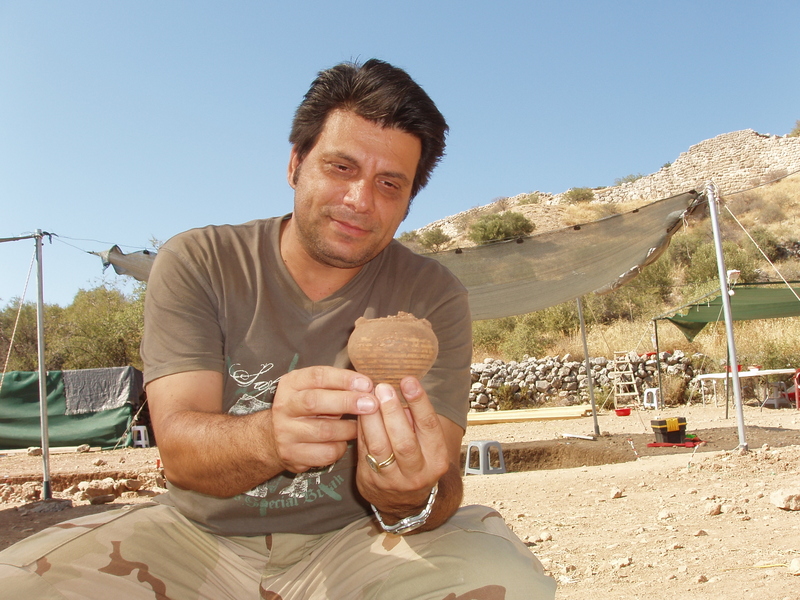 Director C. Maggidis holds artifact after discovery of Geometric Grave
Director C. Maggidis holds artifact after discovery of Geometric Grave
_______________________________________
For more information see the Project website: http://mycenae-excavations.org
Contact information to participate or donate to the project: contact Prof. Chr. Maggidis at [email protected] and (717) 245-1014
All images, unless otherwise noted, are credit Dickinson Excavation Project and Archaeological Survey of Mycenae.
CHRISTOFILIS MAGGIDIS, Ph.D.
C. Roberts Chair, Associate Professor of Archaeology
Department of Archaeology, Dickinson College
President of the Mycenaean Foundation
Assistant to the Director, Mycenae
Director, Geophysical & Archaeological Survey of Glas
Address: Keck Archaeology Lab, P.O. Box 1773, Dickinson College, Carlisle PA 17013
Office tel: (717) 245-1014
E-mail: [email protected]
Personal web-page: http://www.dickinson.edu/~maggidic
Department website: http://www.dickinson.edu/academics/programs/archaeology/
Mycenae website: http://mycenae-excavations.org
Glas website: http://glas-excavations.org
___________________________________________

